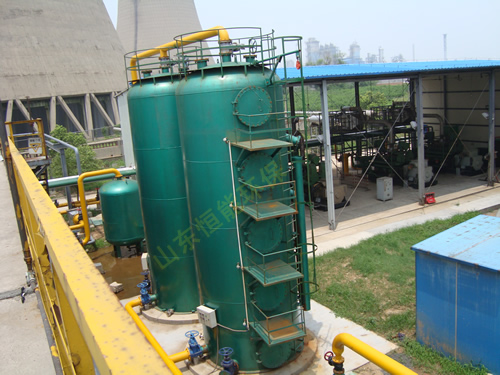欢迎进入山东恒能环保能源设备有限公司
欢迎进入山东恒能环保能源设备有限公司
目前,国内外主流的沼气脱硫工艺包括化学脱硫、生物脱硫、湿法水洗脱硫等工艺。?化学脱硫(干法脱硫)化学脱硫反应基本原理是:H2S与脱硫剂(氧化铁)接触,被氧化成硫或硫氧化物的一种方法,也可称为干式氧化法。干法脱硫设备的基本构成是:在特制的脱硫罐中放入填料(填料为氧化铁),气体以低流速从一端经过脱硫塔内填料层,把H2S吸附或吸收反应成硫化物或多硫化物后,余留在填料层中,净化后气体从脱硫塔另一端排出,实现脱硫处理的目的。H2S与罐内脱硫剂发生以下化学反应:Fe2O3·H2O+3H2S→Fe2S3·H2O+3H2O罐内脱硫剂定期晾晒再生,循环使用数次后更换。脱硫剂再生反应如下:2Fe2S3·H2O+3O2→2Fe2O3·H2O+6S脱硫剂脱硫及再生过程中,H2S与Fe2O3反应生成Fe2S3,Fe2S3与空气接触后又生成单质硫和Fe2O3。如此H2S被氧化成单质硫除去,同时脱硫剂得以再生。优势:一次性投资低,运行稳定,结构简单,使用方便。劣势:运行成本较高,脱硫剂失效快,需定期更换脱硫剂。
At present, the mainstream biogas desulfurization processes at home and abroad include chemical desulfurization, biological desulfurization, wet water washing desulfurization, and other processes.? The basic principle of chemical desulfurization (dry desulfurization) is that H2S comes into contact with a desulfurizer (iron oxide) and is oxidized into sulfur or sulfur oxides, also known as dry oxidation method. The basic composition of dry desulfurization equipment is to place packing (iron oxide packing) in a specially designed desulfurization tank, and the gas passes through the packing layer in the desulfurization tower at a low flow rate from one end. H2S is adsorbed or absorbed and reacted into sulfides or polysulfides, which remain in the packing layer. After purification, the gas is discharged from the other end of the desulfurization tower to achieve the purpose of desulfurization treatment. H2S undergoes the following chemical reaction with the desulfurizer in the tank: Fe2O3 · H2O+3H2S → Fe2S3 · H2O+3H2O. The desulfurizer in the tank is periodically dried and regenerated, and is replaced after several cycles of use. The regeneration reaction of desulfurizer is as follows: 2Fe2S3 · H2O+3O2 → 2Fe2O3 · H2O+6S. During the desulfurization and regeneration process of desulfurizer, H2S reacts with Fe2O3 to generate Fe2S3, which then reacts with air to produce elemental sulfur and Fe2O3. In this way, H2S is oxidized to elemental sulfur for removal, while the desulfurizer is regenerated. Advantages: Low one-time investment, stable operation, simple structure, and easy to use. Disadvantages: High operating costs, rapid failure of desulfurizers, and the need for regular replacement of desulfurizers.
生物脱硫生物脱硫技术的原理为:通过营造脱硫菌适宜的工作环境,使沼气中H2S在脱硫菌的生物氧化还原作用下生成单质硫被去除。脱硫系统属开放系统,微生物种群随环境改变而变化。在大多数生物发酵罐中,微生物种类以细菌为主、真菌为次,极少有酵母菌;常用的细菌是硫杆菌属的氧化亚铁硫杆菌、脱氮硫杆菌及排硫杆菌,最成功的代表是氧化亚铁硫杆菌,其生长的最佳pH值为2.0~2.2。从沼气发酵罐内导出的气体进入生物脱硫塔,同时从发酵罐内抽出部分发酵液,用泵将发酵液从生物脱硫塔的底部抽到顶部进行淋洒,发酵液的作用是发酵液当中含有很多微生物,与沼气中的H2S作用后,能够生成含有硫单质的细菌,存在于生物脱硫塔内部的填充层里,这种细菌是好氧性细菌,因此,在进行生物脱硫前,沼气应预先通过鼓风机注入微量的空气(O2),使其处于好氧状态。如果没有与H2S相遇,可以消耗自身成为H2SO4,通过发酵液的循环而排放出去;发酵液经过循环后,当其pH值降到2时,需要重新更换,原来的废水则流到贮液池等待好氧处理。利用注入的空气和营养液中的水分发生以下氧化还原反应:2H2S+O2→2H2O+2S2S+3O2+2H2O→2H2SO4H2S在脱硫菌的作用下进行氧化还原反应后,生成单质硫和H2SO4,贮存于塔内填料和营养液内,通过填料上生物膜的脱落和营养液的定期外排净化。优势:运行费用低,无需催化剂或氧化剂,无需更换滤料,脱硫效率高。劣势:一次性投资高,过程不易控制,沼气中氧残留量不易控制。
The principle of biological desulfurization technology is to create a suitable working environment for desulfurization bacteria, so that H2S in biogas can be removed by the biological oxidation-reduction of desulfurization bacteria to generate elemental sulfur. The desulfurization system is an open system, and the microbial population changes with environmental changes. In most biological fermentation tanks, bacteria are the main microbial species, followed by fungi, with very few yeast; The commonly used bacteria are Acidithiobacillus ferrooxidans, denitrifying Acidithiobacillus, and sulfur excreting Acidithiobacillus, with the most successful representative being Acidithiobacillus ferrooxidans, whose optimal pH value for growth is 2.0-2.2. The gas exported from the biogas fermentation tank enters the biological desulfurization tower, and at the same time, a portion of the fermentation liquid is extracted from the fermentation tank. The fermentation liquid is pumped from the bottom to the top of the biological desulfurization tower for sprinkling. The function of the fermentation liquid is that it contains many microorganisms. After reacting with H2S in the biogas, bacteria containing sulfur can be generated, which exist in the filling layer inside the biological desulfurization tower. These bacteria are aerobic bacteria. Therefore, before carrying out biological desulfurization, a small amount of air (O2) should be injected into the biogas through a blower to keep it in an aerobic state. If it does not come into contact with H2S, it can be consumed to become H2SO4 and discharged through the circulation of fermentation broth; After the fermentation broth is circulated, when its pH value drops to 2, it needs to be replaced again, and the original wastewater flows to the storage tank for aerobic treatment. The following oxidation-reduction reactions occur using the water in the injected air and nutrient solution: 2H2S+O2 → 2H2O+2S2SS+3O2+2H2O → 2H2SO4H2S undergoes oxidation-reduction reactions under the action of desulfurizing bacteria, generating elemental sulfur and H2SO4, which are stored in the tower packing and nutrient solution, and purified through the shedding of biofilm on the packing and regular discharge of nutrient solution. Advantages: Low operating costs, no need for catalysts or oxidants, no need to replace filter media, high desulfurization efficiency. Disadvantages: High one-time investment, difficult process control, and difficulty in controlling residual oxygen in biogas.
湿法脱硫湿法脱硫装置由吸收塔与再生塔组成。用浓度为2%~3%的碳酸钠溶液作为吸收剂,吸收沼气中的H2S。碳酸钠溶液从吸收塔顶部喷淋向下与沼气进行逆流吸收。当硫化氢含量较高,且对净化后气体品质要求非常高的时候采用湿法脱硫。湿法脱硫工艺较为复杂,成本较高,但稳定性较好。表2.3? 几种主要沼气脱硫技术的比较序号对比项优点缺点适用范围1化学脱硫结构简单,使用方便;运行操作简单,无需人员值守。需要定期更换滤料;运行费用较高;脱硫剂失效快。适用于H2S含量低的中小项目或精脱硫环节。2生物脱硫运行费用低,能耗低;无需催化剂或氧化剂;无需更换滤料;脱硫效率高。一次性投资高;过程不易控制;沼气中氧含量不易控制。适用于H2S含量高或大型沼气项目。3湿法脱硫脱硫效果好;稳定性好工艺复杂、成本高对气体净化要求非常高的情况。
The wet desulfurization device consists of an absorption tower and a regeneration tower. Use a sodium carbonate solution with a concentration of 2% to 3% as an absorbent to absorb H2S from biogas. Sodium carbonate solution is sprayed downwards from the top of the absorption tower and undergoes countercurrent absorption with biogas. When the hydrogen sulfide content is high and the quality requirements for the purified gas are very high, wet desulfurization is used. The wet desulfurization process is relatively complex and costly, but it has good stability. Table 2.3? Comparison of several main biogas desulfurization technologies, advantages and disadvantages, applicable scope: 1. Chemical desulfurization has a simple structure and is easy to use; The operation is simple and does not require personnel to be on duty. Regular replacement of filter media is required; High operating costs; The desulfurizer fails quickly. Suitable for small and medium-sized projects or precision desulfurization processes with low H2S content. 2. Low operating costs and energy consumption for biological desulfurization; No need for catalysts or oxidants; No need to replace the filter material; High desulfurization efficiency. High one-time investment; The process is not easy to control; The oxygen content in biogas is difficult to control. Suitable for high H2S content or large-scale biogas projects. 3. Wet desulfurization has good desulfurization effect; Good stability, complex process, high cost, and extremely high requirements for gas purification.
本文由 沼气脱硫 友情奉献.更多有关的知识请点击 https://www.hneee.net/ 真诚的态度.为您提供为全面的服务.更多有关的知识我们将会陆续向大家奉献.敬请期待.
This article is contributed by the friendship of biogas desulfurization For more related knowledge, please click https://www.hneee.net/ Sincere attitude To provide you with comprehensive services We will gradually contribute more relevant knowledge to everyone Coming soon.
相关新闻